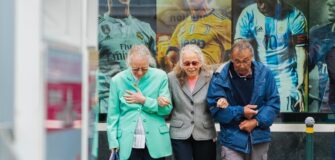Hearing Australia to improve the hearing health of Aboriginal and Torres Strait Islander children
Share
Hearing Australia has established a First Nations Services Unit to better meet the hearing health needs of Aboriginal and Torres Strait Islander children and families.
The Unit will bring together the delivery of Hearing Australia’s three Australian Government funded programs for Aboriginal and Torres Strait Islander peoples: the Hearing Assessment Program – Early Ears (HAPEE) program, the Community Service Obligations (CSO) component of the Hearing Services program and the recently established Listen to Learn program.
“This will help us collaborate with our partners to provide more effective, coordinated, and culturally appropriate services to Aboriginal and Torres Strait Islander peoples across Australia, regardless of their age, location or hearing need,” says Kim.
In 2020-21, Hearing Australia worked with communities across Australia to assess the hearing health of more than 10,000 First Nations children aged zero to six through the HAPEE program.
These assessments are undertaken by highly trained audiologists and are free to families. Checking the ear and hearing health of young children is a critical step to preventing long- term ear disease and hearing loss for the one in four children that are being found to have undiagnosed ear disease or hearing loss, requiring referral to clinical specialists.
Hearing Australia also provided fully subsidised hearing services and devices to more than 11,000 Aboriginal and Torres Strait Islander peoples through the CSO program.
Hearing Australia has delivered outreach services and worked with Aboriginal and Torres Strait Islander communities for over 40 years. Currently, Hearing Australia provides outreach services to 285 communities and this number continues to grow.
Research also shows the long-term benefits of supporting and working with local communities. In 2008, just 4.6% of Aboriginal or Torres Strait Islander children with a hearing loss aged under 20 were aided with a hearing device before the age of three years. By 2020, this had lifted to 12.7%, thereby reducing the impacts of hearing loss on their development and education.
The First Nations Unit works with Aboriginal and Torres Strait Islander peak bodies, ear health coordinators and other key ear health stakeholders to address the high rates of ear disease and hearing loss in First Nations children. Aboriginal and Torres Strait Islander children have some of the highest rates of middle ear infection, otitis media, in the world.
Matthew Brown, Director of Queensland Health’s Deadly Ears Program, says that with Hearing Australia and Deadly Ears working together, children with ear and hearing problems are increasingly getting the help they need.
“Across Queensland, the Deadly Ears Program and Hearing Australia work closely to support Aboriginal and Torres Strait Islander children experiencing hearing loss. We work together to ensure that children receive timely and effective care and our collaboration on telehealth services has seen a significant reduction in the age of first hearing aid fitting for Aboriginal and Torres Strait Islander children.”
Matthew adds, “Our relationship with Hearing Australia’s HAPEE Program is growing. HAPEE identifies kids with hearing loss in the crucial zero to six age group and those with conductive hearing loss associated with middle ear disease are referred to the Deadly Ears Program for review with an ear, nose and throat specialist and possible surgery.”
Hearing Australia Community Engagement Officer and proud Aboriginal woman, Emma Sparrow, says that telehealth appointments have been a great addition to Hearing Australia’s services.
“Telehealth allows us to continue to provide the support kids need, and it helps us quickly identify those who need more urgent treatment or follow-ups. If we can pick up a child’s hearing loss early, it’s a better outcome for the child.
“Hearing loss can lead to disruption of listening and communication skills that are critical for a child’s learning. Without regular screenings, kids who have fluctuating hearing loss may fall through the cracks and have a higher risk of cognitive, speech and language developmental delays that can lead to problems at school,” says Emma.
“Our team works collaboratively with organisations such as Aboriginal community-controlled health organisations, state government and private health clinics, play groups and early education centres to take the necessary action to help kids not just survive, but thrive throughout their school years and adult life.”
As well as hearing checks, the First Nations Services Unit also provides local training and support services online and in-person. Upskilling and supporting primary health care professionals and early childhood educators who care for or provide initial hearing health assessments and screenings, is an integral part of the services offered through the Unit.
Hearing Australia has committed to reducing the rate of hearing loss in Aboriginal and Torres Strait Islander children by at least half by 2029. To achieve this goal, the organisation continues to strengthen its relationships with key First Nations ear health organisations and experts, by working together to develop an action plan to help improve the hearing health of Aboriginal and Torres Strait Islander children.
Original content from Third Sector News. Note: Content has been edited for style and length.
Nina Alvarez is a Content Producer for Healthcare Channel. Her interests include writing, particularly about the healthcare sector and the many ways it can improve to further benefit people from all walks of life.













